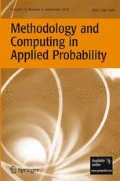Abstract
We introduce a parametric family for random convex polytopes in ℝd which allows for an easy generation of samples for further use, e.g., as random particles in materials modelling and simulation. The basic idea consists in weighting the Poisson cell, which is the typical cell of the stationary and isotropic Poisson hyperplane tessellation, by suitable geometric characteristics. Since this approach results in an exponential family, parameters can be efficiently estimated by maximum likelihood. This work has been motivated by the desire for a flexible model for random convex particles as can be found in many composite materials such as concrete or refractory castables.
Similar content being viewed by others
References
Baumstark V, Last G (2009) Gamma distributions for stationary Poisson flat processes. Adv Appl Prob (SGSA) 41:911–939
Bickel PJ, Doksum KA (2007) Mathematical statistics: basic ideas and selected topics, 2nd edn, vol I. Prentice Hall
Calka P (2001) Mosaïques poissoniennes de l’espace euclidien. Une extension d’un résultat de R. E. Miles. CR Acad Sci I-Math 332:557–562
Calka P (2010) Tessellations. In: Kendall W, Molchanov I (eds) New perspectives in stochastic geometry. Oxford University Press
Coster M, Chermant JL (2002) On a way to material models for ceramics. J Europ Cer Soc 35:1191–1203
De Pellegrin DV, Stachowiak GW (2005) Simulation of three-dimensional abrasive particles. Wear 258:208–216
Fleischer F, Gloaguen C, Schmidt V, Voss F (2009) Simulation of the typical Poisson–Voronoi–Cox–Voronoi cell. J Stat Comput Simul 79(7):939–957
Gilks WR, Richardson S, Spiegelhalter DJ (1996) Introducing Markov chain Monte Carlo. In: Gilks WR, Richardson S, Spiegelhalter DJ (eds) Markov chain Monte Carlo in practice. Chapman & Hall, London
Hawkins AE (1993) The shape of powder-particle outlines. Research Studies Press, Taunton, Somerset, England and J. Wiley and Sons, New York, Chichester
He H, Guo Z, Stroeven P, Stroeven M, Sluys LJ (2010) Strategy on simulation of arbitrary-shaped cement grains in concrete. Image Anal Stereol 29:79–84
Hilhorst HJ (2009) Heuristic theory for many-faced d-dimensional Poisson–Voronoi cells. J Stat Mech P08003:1–14
Hilhorst HJ, Calka P (2008) Random line tessellations of the plane: statistical properties of many-sided cells. J Stat Phys 132:627–647
Hug D, Schneider R (2007) Asymptotic shapes of large cells in random tessellations. Geom Funct Anal 17:156–191
Lantuéjoul C (2002) Geostatistical simulation. Springer, Berlin
Lautensack C, Zuyev S (2008) Random Laguerre tessellations. Adv Appl Prob (SGSA) 40:630–650
Lee Y, Fang C, Tsou YR, Lu LS, Yang CT (2009) A packing algorithm for three-dimensional convex particles. Granular Matter 11:307–315
May JH, Smith RL (1982) Random polytopes: their definition, generation and aggregate properties. Math Program 24:39–54
Miles RE (1971) Poisson flats in Euclidean spaces. Part II: homogeneous poisson flats and the complementary theorem. Adv Appl Prob 3:1–93
Molchanov IS, Stoyan D (1996) Statistical models of random polyhedra. Commun Statist—Stoch Models 12(2):199–214
Møller J, Zuyev S (1996) Gamma-type results and other related properties of poisson processes. Adv Appl Prob 28:662–673
Ohser J, Schladitz K (2009) 3D images of material structures. Wiley-VCH, Weinheim
Quenec’h JL, Chermant JL, Coster M, Jeulin D (1994) Liquid phase sintered materials modelling by random closed sets. In: Serra J, Soille P (eds) Mathematical morphology and its applications to image processing. Kluwer Academic Pub., Dordrecht, pp 225–232
Rao CR (1973) Linear statistical inference and its applications, 2nd edn. Wiley, New York
Schneider R (1993) Convex bodies: the Brunn–Minkowski theory. Cambridge University Press, Cambridge
Schneider R, Weil W (2008) Stochastic and integral geometry. Springer, Berlin
Stoyan D, Stoyan H (1994) Fractals, random shapes and point fields. Wiley, Chichester
Stoyan D, Davtyan A, Turetayev D (2002) Shape statistics for random domains and particles. In: Mecke K, Stoyan D (eds) Morphology of condensed matter. Physics and geometry of spatially complex systems. Lecture notes in physics. Springer, Berlin
Author information
Authors and Affiliations
Corresponding author
Rights and permissions
About this article
Cite this article
Ballani, F., van den Boogaart, K.G. Weighted Poisson Cells as Models for Random Convex Polytopes. Methodol Comput Appl Probab 16, 369–384 (2014). https://doi.org/10.1007/s11009-013-9342-y
Received:
Revised:
Accepted:
Published:
Issue Date:
DOI: https://doi.org/10.1007/s11009-013-9342-y




